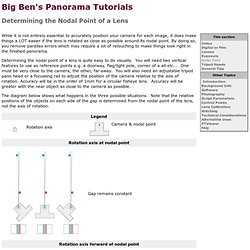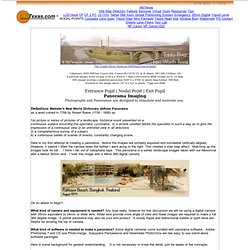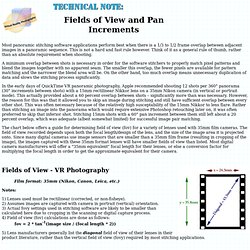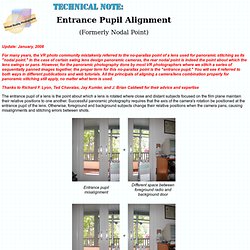

Finding the Lens Parameter. Go directly to the calculator One problem that commonly plagues QTVR artists is the problem of finding the correct lens parameter for a given camera or lens used for shooting a QTVR panorama. This is the stitcher "Vertical Field of View" or VFOV, the angle that has its apex the center of the Panorama cylinder and the lines of sight to the top and bottom of the cylinder defining the sides of the angle. Both PanoWorx and Nodester have a large number of templates for 35 mm camera lenses and digital cameras that include the VFOV value. QTVRAS has only a few lens settings preconfigured. But new digital cameras with different lens parameters keep coming out.
Panoramic Tripod Heads, Virtual Tours, Stitching Software and Hardware, Precision and adjustable panoramic heads. FOV Calculator. How to Create Stereo Photographs wikiHow. Edit Article Single CameraTwo Cameras Edited by Keith Taylor, Krystle C., Jack Herrick, Ben Rubenstein and 15 others Do you want to make your own stereo photographs and view your memories in amazing, full-colour, 3-dimensional detail?

With one or two cameras and a tripod, you can make this happen with great success! Keep reading for detailed information on how to create stereo photographs. Ad. How to... VRwave. Intro To Panoramas. Nodal Point. Nodal Point. While it is not entirely essential to accurately position your camera for each image, it does make things a LOT easier if the lens is rotated as close as possible around its nodal point.

By doing so, you remove parallax errors which may require a lot of retouching to make things look right in the finished panorama. Determining the nodal point of a lens is quite easy to do visually. You will need two vertical features to use as reference points e.g. a doorway, flag/light pole, corner of a all etc... One must be very close to the camera, the other, far away. Nodal Points.
The Trinity River Vision at 360Texas.com website 12January 2005 0945am Canon 20d, Canon 28-135 IS UL @ fl 28mm, ISO 200 1/160sec f/8. 8 portrait images RAW format 2336 h x 3504 w 7.8mb converted to BMP format each 23.4mb 30% image overlap completed panorama 3247 h x 9764 w pixels bmp format 108.9mb Resized to the image above 147 h x 521 w pixels 72ppi and 60kb Entrance Pupil | Nodal Point | Exit Pupil Panorama Imaging Photographs and Panoramas are designed to stimulate and motivate you.

Definition Webster's New World Dictionary defines Panorama: as a word coined in 1789 by Robert Baker (1739 - 1806) as: Here is my first attempt at creating a panorama. Notice the images are similarly exposed and somewhat vertically aligned. FOV & Pan Increments. Most panoramic stitching software applications perform best when there is a 1/3 to 1/2 frame overlap between adjacent images in a panoramic sequence.

This is not a hard and fast rule however. Think of it as a general rule of thumb, rather than an absolute requirement when shooting. A minimum overlap between shots is necessary in order for the software stitchers to properly match pixel patterns and blend the images together with no apparent seam. The smaller this overlap, the fewer pixels are available for pattern matching and the narrower the blend area will be. On the other hand, too much overlap means unnecessary duplication of data and slows the stitching process significantly. In the early days of QuickTime VR panoramic photography, Apple recommended shooting 12 shots per 360° panorama (30° increments between shots) with a 15mm rectilinear Nikkor lens on a 35mm Nikon camera (in vertical or portrait mode).
Fields of View - VR Photography Film format: 35mm (Nikon, Canon, Leica, etc.) VR Nodal Point Alignment. Update: January, 2008 For many years, the VR photo community mistakenly referred to the no-parallax point of a lens used for panoramic stitching as its "nodal point.

" In the case of certain swing lens design panoramic cameras, the rear nodal point is indeed the point about which the lens swings or pans. However, for the panoramic photography done by most VR photographers where we stitch a series of sequentially panned images together, the proper term for this no-parallax point is the "entrance pupil. " You will see it referred to both ways in different publications and web tutorials. All the principals of aligning a camera/lens combination properly for panoramic stitching still apply, no matter what term is used.
Thanks to Richard F. What is Parallax? Parallax causes adjacent pictures for a panorama to differ in ways that prevents them from being stitched together perfectly.

It can cause ghosting, blurring, or even prevent stitching software from being able to work out where to position the pictures to be able to stitch them together. It's really easy to see the effect of parallax: Hold up your index finger in front of you. Close one eye and line up your finger with something further away such as a door, piece of furniture, window, whatever. Parallax Wiki. A simplified illustration of the parallax of an object against a distant background due to a perspective shift.

When viewed from "Viewpoint A", the object appears to be in front of the blue square. When the viewpoint is changed to "Viewpoint B", the object appears to have moved in front of the red square. This animation is an example of parallax.